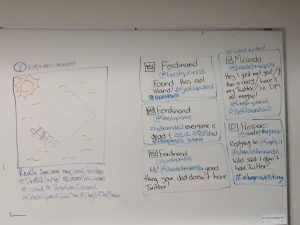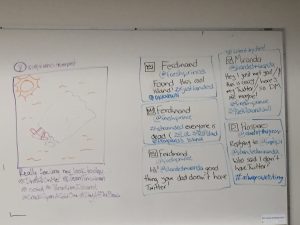SPAN 221 ofrece una comprensión elemental y comprensiva del análisis literario sobre la base de textos españoles e hispanoamericanos. Se introducirán los principales géneros literarios (poesía, ensayo, narrativa, drama) con su correspondiente terminología del lenguaje literario. Además se situarán a los autores y los textos en sus contextos históricos, geográficos, políticos y culturales. Please see the most recent syllabus for this course here: Syllabus Spanish 221 T 1 2018
Category Archives: Uncategorized
Protected: Spanish 365: Modern Magics
Arts Oneb: Authority and Resistance
ArtsONEb is an invitation to unpack why “authority and resistance” has concerned some of the most noteworthy thinkers and revolutionary actors of the past and defined recent thematic trends in the arts, politics, and beyond. It is an opportunity to actively engage in a dialogue – both through conversation and written work in an academic context – about the value of looking to the past to better comprehend present circumstances and even to project future occurrences. See the current course syllabus for my section here: Authority and Resistance Syllabus 2017
Teaching Writing
Blogs
Beyond this ePortfolio site, I have a blog called Quare that reflects on intuitive approaches to and practices in teaching and learning. I also manage the FHIS Learning Centre Blog, Beyond the Page. This site hosts helpful tips for students learning additional languages (mainly Spanish) and provides links to the centre’s online schedule, which you can also find here.
FHIS Learning Centre

The FHIS Learning Centre
The FHIS Learning Centre is a volunteer-based centre, staffed by students enrolled in FHIS undergraduate or graduate courses. It services students in all of the languages taught in the FHIS Department – French, Italian, Portuguese, and Spanish – and at all levels of our curricula (from novice language courses to advanced language and literature ones).
A Holistic and Community-Oriented Approach to Student Engagement
The FHIS Learning Centre is informed by an integrative holistic approach to the teaching of foreign language sand literatures that hones in on key skills needed for effective communication in classroom-created and real-life contexts. This communicative and community-oriented focus of the operation has been successful at creating an open and interactive learning community for students that is closely aligned with specific course learning objectives and abilities needed for effective and authentic communication in the target language.
The Director’s Role
I currently serve as Director of the FHIS Learning Centre. As director, I collaborate with the Learning Centre Coordinator to train and provide professional development for tutors and lead the recruitment and selection process of student volunteers. I routinely collect data on student experiences through participation counters, session reflections, tutor surveys, and focus groups to ensure that student, tutor, and faculty feedback is taken into account for upcoming sessions and programming. The centre, as promoted in national and international standards for teaching and learning additional languages (i.e. ACTFL and CEFR) strives to innovate approaches to additional language instruction in small-group settings and to increase student confidence, proficiency, and readiness for applying knowledge to a real-world context in a way that is also aligned with FHIS course and program learning outcomes.
Go here to learn more about this service and what we do.
In-class Assignments and Activities
Language Classes
- Review of Key Phrases and Characters Volver
- SPAN 202 Information Gap Activity Lesson 7 Vocabulario cultural
- Con los ojos cerrados Actividad de dibujar
- Kahoot: Review of the Preterit and Imperfect (Spanish)
Literature and Culture Classes
- Ejercicio dibujando Volver
- Discussion Leader Sessions
- Spanish 364 Debate Activity Las Casas y Sepúlveda
- Kahoot: Spanish 222 Review of “Music” as Cultural Genre
- Warm-up Activity Art and Education

Arts One b: Authority and Resistance
Spanish 401: Translation
Spanish 401 is an intensely practical introduction to the art and skill of translation both from Spanish to English and English to Spanish. Through a variety of activities from different professional specializations (Business, Journalism, Public Relations, and Literary and Cultural Studies), students will work through translation theories and techniques, grammatical and structural overlaps (or divergences) between Spanish and English, and grapple with questions of fidelity and fluidity when interpreting voice, culture, and text. This course also provides a brief introduction to simultaneous interpretation as it is done in the professional settings studied. Ultimately, students will improve writing skills and fluency in Spanish and overall understanding of the translation process and all of its intricacies. Participants must be highly proficient in both Spanish and English.
Spanish 406: Gender and the Politics of Space in Spanish America (S. XVII-S. XX)
In SPAN 406, students will evaluate how different Spanish American authors from the 17th – 20th centuries explore the idea of gender as a category of analysis in literature situated in diverse enclosed spaces (the convent, the jail cell, the psychological institution, and others). More specifically, we will evaluate how selected authors promote or move away from the “normative” codes of gender present in society and if and when such codes incorporate and/or compete with other identity categories such as race, class, and ethnicity, and so on. As one of the overarching goals of the course is to engage students in scholarly dialogues on gender, students will explore the construction, performance, and variations of gender through critical and theoretical approaches to the topic and in relation to the literary corpus of the course.
Masking Revolution: Subcomandante Marcos and the Contemporary Zapatista Movement (June, 2017)
Masking Revolution Subcomandante Marcos and the Contemporary Zapatista Movement examines the historical shift from a Cold War to a post-Cold War Latin America in order to explain how and why the Zapatista Movement in Mexico began as a utopian revolutionary campaign that strictly followed Ernesto “Che” Guevara’s foco theory and ended up as a symbolic war against injustice – an (inter)national campaign for “absolute democracy” that promoted an imagined community or utopia of the twenty-first century. Within this framework, I dissect how Subcomandante Marcos’s revolutionary performances use words, fictional characters (heteronyms), and masks as tactics with practical utopian effects, always rooted in the land.



